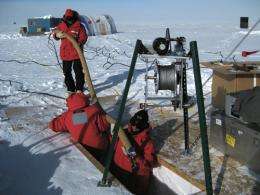Antarctica rocks!

Geologist John Goodge looks for clues about Antarctica's past in the 2 percent of the continent that is not covered in ice!
The University of Minnesota-Duluth professor has been visiting Antarctica since 1985, finding and studying rocks that help tell the story of how this desolate continent has formed and changed over time.
In late 2010 and early 2011, he spent several weeks in the field, with other scientists, visiting a dozen sites along 1,200 miles of mountains.
"What we're doing is finding places along the Transantarctic Mountains and we are sampling those to pick up pieces of rock that can, hopefully, give us some examples of what's further under the ice sheet," he says.
Goodge and his colleagues are supported by the U.S. Antarctic Program, which is managed by the National Science Foundation (NSF).
The team first spent about three weeks preparing for its fieldwork at McMurdo Station, the main U.S. research facility in Antarctica.
Goodge says the "Antarctic experience" is a combination of the starkness of the terrain and the camaraderie of co-workers.
"In Antarctica, you have chances to sit down and socialize in a setting that you might not otherwise have so it's really fun. I meet people that are working on meteorology, sending weather balloons up, and people that study Antarctic fish that make their own antifreezes, and just all kinds of neat things," he says.
Long before touching down on the ice, scientists spend months determining what would likely be the most productive sites. They use a combination of satellite imagery and topographic maps. U.S. Geological Survey photos taken in the 1950s and 60s are now digitally available, helping pinpoint study sites. Goodge says getting the right experts together is also critical.
"I learned a long time ago that it is rewarding to pick a team of people who bring different expertise to what you're doing, and so I see myself as kind of the hub in a spoked wheel of people doing different things," he says.
His team included a certified guide and mountaineer, a graduate student from South Africa, an isotope geochemist, and a geochronologist.
They travelled in helicopters to get to sites within a couple hundred miles of McMurdo, and planes to get to sites located further away.
The rocks they collect give clues about our planet and what it was like before the seven continents we know now.
"When we think about Earth's history and tectonics, we come to understand that there have been several periods in history where we think there have been supercontinents; amalgamations of most, if not all the continents we know today. Pangea is the latest one; it was around 250 million years ago. Before Pangea assembled, there was another supercontinent that most people agree was in existence 500 million years ago, Gondwana," explains Goodge.
And another piece of very ancient history: "It turns out there are rocks and glacial deposits that we've been finding that actually seem to confirm the idea that Antarctica and North America would have been neighbors at one time!" says Goodge.
The team collected about 2,500 pounds of rock material, filling 30 sturdy wooden boxes.
Opening them up to analyze them, "is like having Christmas time back here," says Goodge jokingly.
"This particular rock, this granite, is loaded with the mineral zircon, which is good for us because zircon's structure has the ability to take up small amounts of uranium, which then decays naturally to isotopes of lead, which we can use as a clock," he explains, while holding up a rock from his latest trip. "We can analyze the zircon to tell how old this rock was when it formed. And also the isotope composition can tell us about the ancestry of the granite itself."
According to Goodge, Antarctica may not seem like it is very active, but in fact it is a dynamic environment. And it is an important place to study the health of the planet--including the impact of global climate change on ice sheet stability.
"And, if we can understand what's happened in the past, we have at least a way or a framework to be able to say what might happen in the future and then, of course, with respect to climate change, the question is what extra role do humans and their activity play in tweaking the natural system off of whatever cycles it may have already been on?" notes Goodge.
While he has traveled there many times, Goodge says the Antarctic environment is still exciting and unpredictable.
"One of the interesting things about being in Antarctica is that you have no sense of scale. If you're out hiking in the mountains in the western United States, you can see trees and you can see roads, and so you have a sense of how far things are and how big things really are. But in Antarctica, it's just an expanse of white, and it's rolling, and it might even be mountainous and there might be a lot of glaciers. It's beautiful scenery and yet, the distances are so deceiving. You feel very small, and it's fun to just witness the things that are going on around you," he says.
For Goodge, this frozen landscape is full of ancient clues just waiting to be interpreted.
Provided by National Science Foundation














